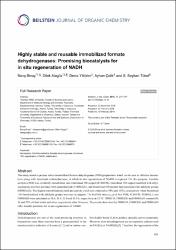| dc.contributor.author | Binay, Barış | en_US |
| dc.contributor.author | Alagöz, Dilek | en_US |
| dc.contributor.author | Yıldırım, Deniz | en_US |
| dc.contributor.author | Çelik, Ayhan | en_US |
| dc.contributor.author | Tükel, S. Seyhan | en_US |
| dc.date.accessioned | 2017-08-01T12:26:31Z | |
| dc.date.available | 2017-08-01T12:26:31Z | |
| dc.date.issued | 2016 | |
| dc.identifier.citation | Binay, B., Alagöz, D., Yıldırım, D., Çelik, A., Tükel, S. S. (2016). Highly stable and reusable immobilized formate dehydrogenases: Promising biocatalysts for in situ regeneration of NADH. Beilstein J. Org. Chem. 2016.12, 271–277. | en_US |
| dc.identifier.uri | https://hdl.handle.net/20.500.12294/884 | |
| dc.identifier.uri | http://dx.doi.org/10.3762/bjoc.12.29 | |
| dc.description | Binay, Barış (Arel Author) | en_US |
| dc.description.abstract | This study aimed to prepare robust immobilized formate dehydrogenase (FDH) preparations which can be used as effective biocatalysts along with functional oxidoreductases, in which in situ regeneration of NADH is required. For this purpose, Candida methylica FDH was covalently immobilized onto Immobead 150 support (FDHI150), Immobead 150 support modified with ethylenediamine and then activated with glutaraldehyde (FDHIGLU), and Immobead 150 support functionalized with aldehyde groups (FDHIALD). The highest immobilization yield and activity yield were obtained as 90% and 132%, respectively when Immobead 150 functionalized with aldehyde groups was used as support. The half-life times (t1/2) of free FDH, FDHI150, FDHIGLU and FDHIALD were calculated as 10.6, 28.9, 22.4 and 38.5 h, respectively at 35 °C. FDHI150, FDHIGLU and FDHIALD retained 69, 38 and 51% of their initial activities, respectively after 10 reuses. The results show that the FDHI150, FDHIGLU and FDHIALD offer feasible potentials for in situ regeneration of NADH. | en_US |
| dc.language.iso | eng | en_US |
| dc.relation.ispartof | Beilstein Journal of Organic Chemistry | en_US |
| dc.rights | info:eu-repo/semantics/openAccess | en_US |
| dc.title | Highly stable and reusable immobilized formate dehydrogenases: Promising biocatalysts for in situ regeneration of NADH | en_US |
| dc.type | article | en_US |
| dc.department | İstanbul Arel Üniversitesi, Fen-Edebiyat Fakültesi, Moleküler Biyoloji ve Genetik Bölümü | en_US |
| dc.authorid | TR16264 | en_US |
| dc.authorid | TR51429 | en_US |
| dc.authorid | TR30632 | en_US |
| dc.authorid | TR10281 | en_US |
| dc.authorid | TR10053 | en_US |
| dc.identifier.volume | 2016 | en_US |
| dc.identifier.issue | 12 | en_US |
| dc.identifier.startpage | 271 | en_US |
| dc.identifier.endpage | 277 | en_US |
| dc.relation.publicationcategory | Makale - Ulusal Hakemli Dergi - Kurum Öğretim Elemanı | en_US |


















